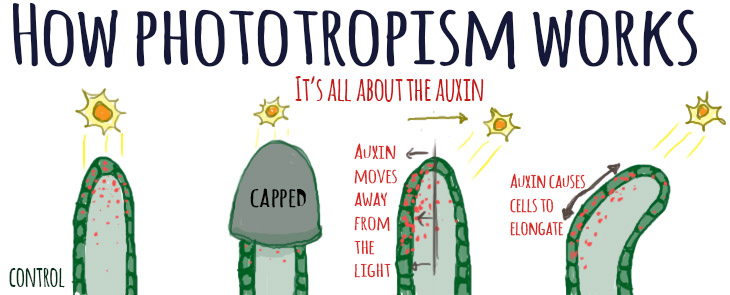
- Plant Biology
- Human Biology
- Biology Plant Biology Phototropism Experiment

Experiment: How do plants “see” light?
Can plants really “see” the light.
Scientists call a plant’s ability to bend toward light phototropism . Even as far back as ancient Greece it’s been a big puzzle about how plants are able to do it. People experimented with how plants accomplish this amazing feat, but no one really figured out how it worked—until Charles Darwin came along, that is.
Although Darwin is most well-known for his studies on evolution, he was also a prolific scientist in general. The questions about phototropism piqued his curiosity, and he thought of an ingenious experiment to test how plants are able to see light. In this experiment, we’ll recreate what he did, and at the end we’ll dive further into the science.

3 small cups full of soil Tape, a marker, and 3 sticky notes Medium-sized box (such as a shoebox or a storage cube) 12 corn seeds Aluminum foil Small cookie sheet that fits inside the box (or another sheet of aluminum foil) 1 Straw Water
- Plant four corn seeds in each of the soil cups. Make sure they’re evenly spaced, and plant them just a half inch under the dirt.
- Water the cups, and dump out any excess water (be careful not to tip the soil and seeds out). Place the cups on the cookie sheet or aluminum foil. This will prevent moisture and dirt from soaking through the box.
- Place the cups/cookie sheet setup inside of the box. Make sure it’s open on one side so that light is coming in from an angle. Place in a windowsill, with the open side facing the sun. (You might need to stack some books underneath it to support it, if your windowsill isn’t very wide.)
- Shoot cap: Cut a small 2″ x 3″ square of aluminum foil. Wrap it around the tip of a straw to create a small, closed-ended metal cap, and slide it off. This will be placed over the tip of the growing shoot to cover any light coming in to the tip.
- Base sleeve: Cut a small 1/2″ x 3″ square of aluminum foil. Wrap it around the middle of a straw so it creates a small open-ended 1/2″ tall tube, and slide it off. This will be placed around the growing shoot so that it can grow through it.
- Check the cups each day. Once they send up a shoot about half an inch high, place either a shoot cap (on Tip seedlings) or a base sleeve (on Base seedlings) around them, depending on which cup they’re in. The control cup will get neither of the light exclusion devices. The seedlings might grow at different rates, so be sure to check each day to put the caps/sleeves on as needed. They grow fast once they germinate!
- Continue to water the seedlings as needed.
- Check the seedlings after a week. What has happened? Compare the seedlings with the caps and the sleeves to the control seedlings. Are any of them growing in certain directions?
How did the seedlings “see” the light?
If the experiment worked correctly, you should have noticed that the seedlings that were covered with caps at the tip grew straight up, while the control seedlings and the seedlings with the bases covered bent towards the light. This is phototropism in action.
Darwin correctly concluded that plants are able to “see” light using the tips of the plant shoots, rather than through the stalks. It wasn’t until a bit later that scientists figured out exactly why that was, though.
It turns out that plants are able to grow by using hormones such as auxins and gibberellins . Auxin in particular tells individual cells to reach out and grow longer, like Stretch Armstrong. It’s one of the ways that plants grow taller. Normally, plants growing with an unshaded light source will grow straight up towards the sun because auxin is evenly distributed all around the shoot.
But when the light is heavily shaded and comes in from an angle, something interesting happens. Auxin starts to concentrate on the shaded side of the plant instead, and as a result, the cells on the sunny side stay the same size but the cells on the shaded side grow longer. This causes the plant to tip and grow towards the light.

Auxin is primarily produced in the tips of the plants. This is why the plant grew straight up when you covered the tip with a cap—it couldn’t “see” the light anymore! The tips of the control seedlings and the seedlings with the bases covered could still sense the light, so they grew towards the sunlight.
Thanks to Charles Darwin and modern science, the mystery of how plants grow towards light was finally solved.
Learn more about phototropism:
To understand plant tropisms, you first have to understand plant hormones. We created an excellent page about Plant Growth Hormones here and here .
Related Topics
Choose one of the following categories to see related pages:.
- Experiments ,
Share this Page
Lindsay graduated with a master’s degree in wildlife biology and conservation from the University of Alaska Fairbanks. She also spent her time in Alaska racing sled dogs, and studying caribou and how well they are able to digest nutrients from their foods. Now, she enjoys sampling fine craft beers in Fort Collins, Colorado, knitting, and helping to inspire people to learn more about wildlife, nature, and science in general.

Plant Biology-boo
- Monocots vs Dicots Explained
- Phototropism Experiment
- Plant Diversity
- Plant Growth Hormones
- Plant Memory
- Transport in Plants
- Water Transport Experiment
- Why leaves change color
Science Newsletter:
Full list of our videos.

Teaching Biology?

How to Make Science Films

Read our Wildlife Guide

New From Untamed Science


IMAGES
VIDEO